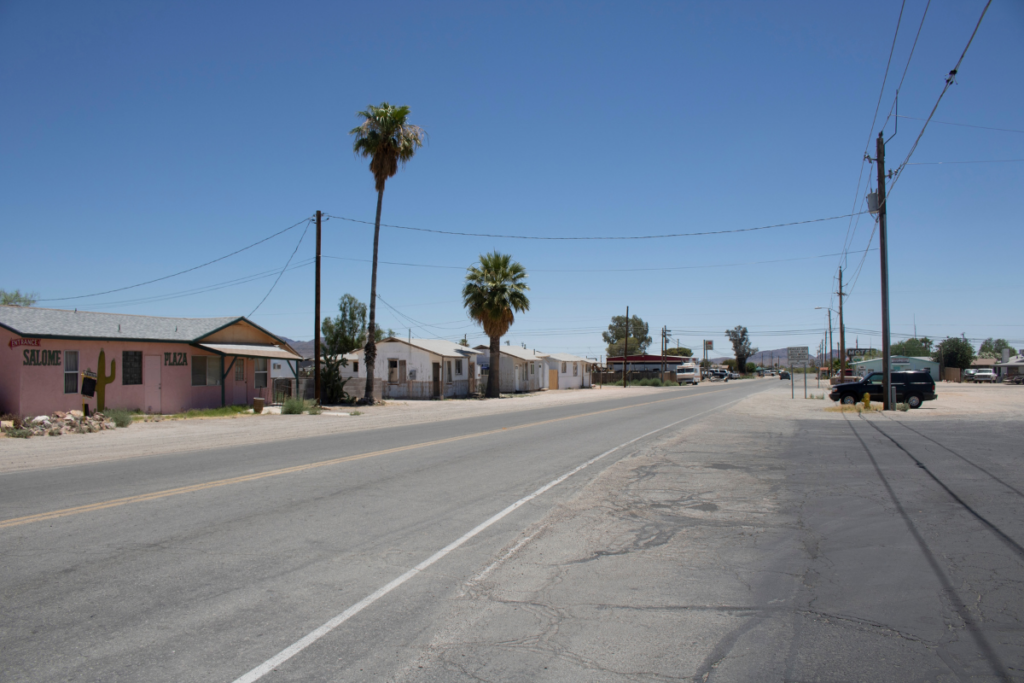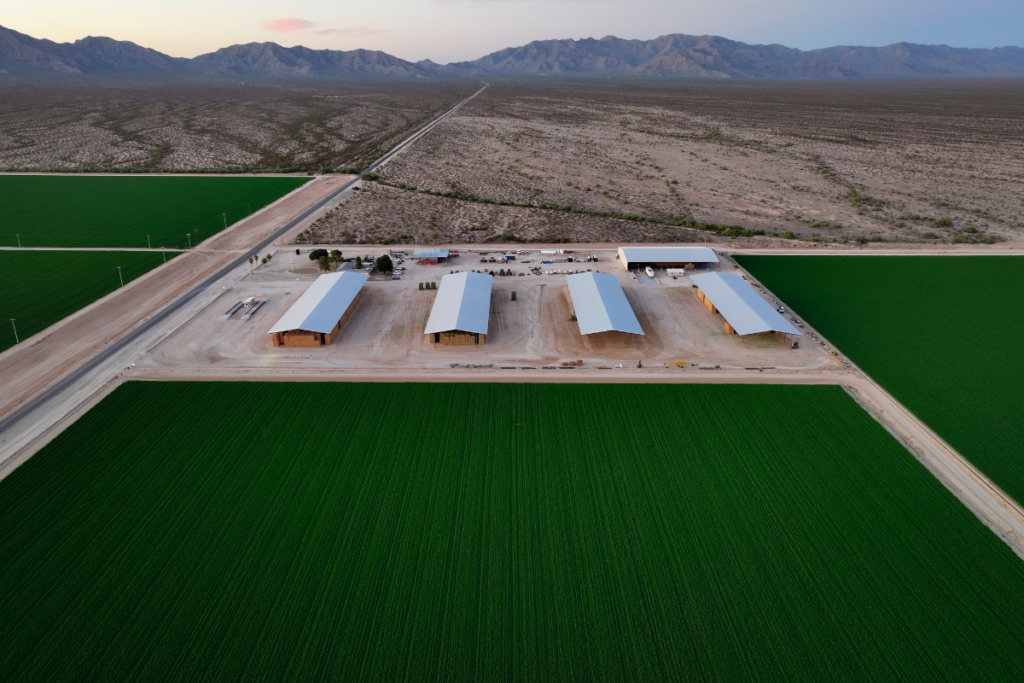
Communities within McMullen Valley have sunk four feet into the ground since 1991—and 12 inches since corporate drilling in the region began in 2015. Illustration by Francesca Daly / Courier Newsroom
Businesses in the United Arab Emirates have been leasing land in rural Arizona so they could pump an unlimited amount of the state’s groundwater—for free.
If this sounds familiar, it should; state officials have been grappling with international companies taking advantage of Arizona’s lax water laws for nearly a decade. And while the impact on the state’s water reserves is long term, the residents of the McMullen Basin are experiencing firsthand the devastating effects of corporate groundwater drilling.
Losing ground
McMullen Valley rests at the intersection of three counties—La Paz, Maricopa, and Yavapai—and is home to the communities of Aguila, Salome, and Wenden, making up fewer than 3,000 residents.
Mostly farmers and retirees, La Paz County Supervisor Holly Irwin says the families that move to McMullen Valley plan to spend the rest of their lives there. But they all share one problem that makes life in the Valley increasingly difficult as the years go on:
They’re sinking.
“The Emiratis are farming and have withdrawn so much water from the ground that the entire town of Wenden has sunk by four feet,” Arizona Attorney General Kris Mayes told The Copper Courier. “It’s stunning, and it’s horrific for the people of Wenden.”
Mayes, who worked alongside Gov. Katie Hobbs in ending a number of drilling permits for international corporate farms, said so much water has been extracted from the land that the ground is sinking, the foundations of buildings are cracking, and one of the state’s most precious natural resources is being depleted at an alarming rate.
“We’ve heard reports of homes being cracked because of the subsidence that’s been caused by that extreme industrial farming, and that’s not okay,” Mayes said. “We are in the midst of a drought. We are in the middle of a crisis, and we cannot be using our groundwater that way.”
@coppercourier No, you’re not having déjà vu: there are more foreign companies pumping Arizona’s groundwater for free. Here’s why this keeps happening. Plus, if you want to get that cool t-shirt that Camaron is wearing, which will help us report on stories like this, click the link in bio🙏 . . . . . . . #drought #climatecrisis #azpol #azwater #arizona #rainyday #everythingarizona #krismayes #katiehobbs #arizonapolitics #azleg
How a town can sink into the ground
The region is experiencing what Mayes and Irwin called land subsidence, a manmade consequence of groundwater withdrawal. It occurs when water made up of fine-grained sediments is extracted from the earth, according to the US Interior Department. This can happen in small, concentrated areas, like with sinkholes, or spread out over a large region, as is the case with McMullen Valley.
In McMullen Valley, land subsidence caused the topsoil to sink three feet over a 25-year period, from 1991 to 2016, according to data from the Arizona Department of Water Resources (ADWR). Irwin first sounded alarm bells about the subsidence in 2010, after the city of Phoenix released a report highlighting the long-term issues continued water extraction could cause.
“In 2010, when these problems started arising, I reached out to the ADWR director, who used to work for the City of Phoenix,” Irwin said. “That’s when I requested updated hydrology studies. And we’re almost in 2024 now, just by a few weeks, and I’ve yet to get any updated hydrology studies.”
Irwin and Mayes both believe corporate drilling will only exacerbate the issue—and so far, they’re right. No hydrology study has been commissioned to determine how much water is left, and since corporate farms moved into the region in 2015, McMullen Valley has sunk another 12 inches.
“I really don’t understand why we keep kicking this can down the road,” Irwin said. “You can only continue to go down this road for so long to where you’re going to see more wells drying up and the quality of water disintegrating.”
What’s being done
In October, Gov. Katie Hobbs’ administration set an end date on Saudi company Fondomonte’s farming in La Paz County, where they had used up millions of gallons of water to grow alfalfa.
But another company—United Arab Emirates-based Al Dahra—is operating virtually the same way Fondomonte has, with no end date in sight.
The actions taken by the Hobbs administration to end Fondomonte’s use of Arizona’s groundwater applied only in that situation, and have no bearing on how other companies can operate.
Companies like Fondomonte and Al Dahra have the money to buy bigger drills for deeper wells, and that’s exactly what they’ve been doing. In 1957, it was only necessary to drill 107 feet to reach water in McMullen Valley. Now, farmers and corporations alike have to drill 542 feet before they can extract groundwater.
And unless the state water department puts a pause on drilling permits, those wells are only going to get deeper.
A representative for Fondomonte declined to comment for this story. Al Dahra did not respond to requests for comment.

The unincorporated community of Salome, Arizona, has sunk four feet deeper into the McMullen Valley since 1991. Image via Shutterstock.
Rehaul state’s water regulations
Mayes, who worked with Hobbs to revoke Fondomonte’s permits, believes the state needs a complete reworking of its groundwater laws.
“We need to overhaul our groundwater laws so that we have more AMAs (active management areas) in the state of Arizona,” said Mayes. The legislature could do that—and, quite frankly, I think the governor and the current director of water management resources, Tom Buschatzke, could also do that—right now.”
Active Management Areas are parts of the state designated as regions with a very finite amount of groundwater, where water levels and usage must be monitored and regulated heavily so we don’t run out.
The whole state isn’t monitored like this because Arizona isn’t just desert—it’s desert, mountain, and plateau—so outside of three major cities—Phoenix, Prescott, and Tucson—and two desert counties—Pinal and Santa Cruz—there is no regulation over how water is drawn from the ground, meaning we have no idea how much water is being used—and more importantly, how much water is left.
Local solution proposed
Irwin has proposed something similar and is currently working with a coalition of supervisors from Mojave, Yavapai, and Coconino Counties on developing what they call local groundwater stewardship areas. With funding, the group hopes to conduct hydrology studies, regulate water extraction, and provide administrative and technical support to water conservation efforts in their respective counties.
The Governor’s Water Policy Council recommended the legislature authorize funding for the group to operate effectively, but Republican Rep. Gail Griffin, who chairs the Committee on Natural Resources, Energy, and Water, left the Council over disagreements over groundwater regulation.
Republican senators introduced legislation earlier this year to formally establish local groundwater stewardship areas, but Griffin never brought their bill to be heard by the committee.
@coppercourier Stopping foreign-owned companies from pumping Arizona’s groundwater is turning into a game of whack-a-mole. Here’s what @azagmayes says can put an end to it. . . . . . . . . #drought #climatecrisis #azpol #azwater #arizona #rainyday #everythingarizona #krismayes #katiehobbs #arizonanews #aznews
Executive action
In lieu of legislative action, Mayes proposed another solution: pause the drilling through executive powers.
“[ADWR Director] Tom Buschatzke, along with the governor, could—right now—put a pause on any new deepwater wells. I wish they would,” Mayes said. “I think there’s a lot the current ADWR could do right now, that they’re not doing.”
Buschatzke and the ADWR did not respond to requests for comment on this story.
But it isn’t likely that ADWR Director Tom Buschatzke will pause any drilling. He was appointed by former Governor Doug Ducey and is one of the few directors Hobbs kept when she became governor.
Buschatzke was the one that approved Fondomonte’s initial drilling permits in 2015, and when questioned, he defended his decision, saying that “those folks have as much right as any other individual in the state of Arizona to grow their produce, grow their crops, sell them, export them.”
But without regulation on how much water can be taken, whoever can dig the deepest can get to the water first—and take as much as they like.

Bales of hay are stored under shelters at Al Dahra Farms, Tuesday, Oct. 17, 2023, in the McMullen Valley in Wenden, Ariz. Worries about future water supplies from ancient aquifers are bubbling up in western rural Arizona. Some neighbors complain that their backyard wells have dried up since the Emirati agribusiness began farming alfalfa nearby. AP Photo/John Locher
Politics

New Biden rules deliver automatic cash refunds for canceled flights, ban surprise fees
In the aftermath of a canceled or delayed flight, there’s nothing less appealing than spending hours on the phone waiting to speak with an airline...

Trump says he would allow red states to track pregnancies, prosecute abortion ban violators
In an interview published by Time magazine this week, former president Donald Trump detailed his plans for a potential second term and said he would...
Local News

Arizona’s Democratic governor signs a bill to repeal 1864 ban on most abortions
PHOENIX (AP) — Democratic Arizona Gov. Katie Hobbs has relegated a Civil War-era ban on most abortions to the past by signing a repeal bill...

VIDEO: Gov. Hobbs signs bill repealing Arizona’s 1864 abortion ban
@coppercourier Today Democratic @govhobbs signed a bill repealing Arizona's 1864 abortion ban. This doesn't mean the ban is gone now,...





